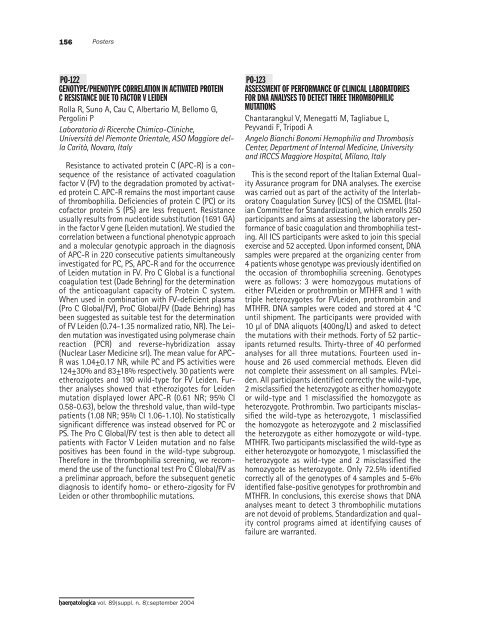Haematologica 2004;89: supplement no. 8 - Supplements ...
Haematologica 2004;89: supplement no. 8 - Supplements ...
Haematologica 2004;89: supplement no. 8 - Supplements ...
- No tags were found...
Create successful ePaper yourself
Turn your PDF publications into a flip-book with our unique Google optimized e-Paper software.
156PostersPO-122GENOTYPE/PHENOTYPE CORRELATION IN ACTIVATED PROTEINC RESISTANCE DUE TO FACTOR V LEIDENRolla R, Su<strong>no</strong> A, Cau C, Albertario M, Bellomo G,Pergolini PLaboratorio di Ricerche Chimico-Cliniche,Università del Piemonte Orientale, ASO Maggiore dellaCarità, Novara, ItalyResistance to activated protein C (APC-R) is a consequenceof the resistance of activated coagulationfactor V (FV) to the degradation promoted by activatedprotein C. APC-R remains the most important causeof thrombophilia. Deficiencies of protein C (PC) or itscofactor protein S (PS) are less frequent. Resistanceusually results from nucleotide substitution (1691 GA)in the factor V gene (Leiden mutation). We studied thecorrelation between a functional phe<strong>no</strong>typic approachand a molecular ge<strong>no</strong>typic approach in the diag<strong>no</strong>sisof APC-R in 220 consecutive patients simultaneouslyinvestigated for PC, PS, APC-R and for the occurrenceof Leiden mutation in FV. Pro C Global is a functionalcoagulation test (Dade Behring) for the determinatio<strong>no</strong>f the anticoagulant capacity of Protein C system.When used in combination with FV-deficient plasma(Pro C Global/FV), ProC Global/FV (Dade Behring) hasbeen suggested as suitable test for the determinatio<strong>no</strong>f FV Leiden (0.74-1.35 <strong>no</strong>rmalized ratio, NR). The Leidenmutation was investigated using polymerase chainreaction (PCR) and reverse-hybridization assay(Nuclear Laser Medicine srl). The mean value for APC-R was 1.04±0.17 NR, while PC and PS activities were124±30% and 83±18% respectively. 30 patients wereetherozigotes and 190 wild-type for FV Leiden. Furtheranalyses showed that etherozigotes for Leidenmutation displayed lower APC-R (0.61 NR; 95% CI0.58-0.63), below the threshold value, than wild-typepatients (1.08 NR; 95% CI 1.06-1.10). No statisticallysignificant difference was instead observed for PC orPS. The Pro C Global/FV test is then able to detect allpatients with Factor V Leiden mutation and <strong>no</strong> falsepositives has been found in the wild-type subgroup.Therefore in the thrombophilia screening, we recommendthe use of the functional test Pro C Global/FV asa preliminar approach, before the subsequent geneticdiag<strong>no</strong>sis to identify homo- or ethero-zigosity for FVLeiden or other thrombophilic mutations.PO-123ASSESSMENT OF PERFORMANCE OF CLINICAL LABORATORIESFOR DNA ANALYSES TO DETECT THREE THROMBOPHILICMUTATIONSChantarangkul V, Menegatti M, Tagliabue L,Peyvandi F, Tripodi AAngelo Bianchi Bo<strong>no</strong>mi Hemophilia and ThrombosisCenter, Department of Internal Medicine, Universityand IRCCS Maggiore Hospital, Mila<strong>no</strong>, ItalyThis is the second report of the Italian External QualityAssurance program for DNA analyses. The exercisewas carried out as part of the activity of the InterlaboratoryCoagulation Survey (ICS) of the CISMEL (ItalianCommittee for Standardization), which enrolls 250participants and aims at assessing the laboratory performanceof basic coagulation and thrombophilia testing.All ICS participants were asked to join this specialexercise and 52 accepted. Upon informed consent, DNAsamples were prepared at the organizing center from4 patients whose ge<strong>no</strong>type was previously identified onthe occasion of thrombophilia screening. Ge<strong>no</strong>typeswere as follows: 3 were homozygous mutations ofeither FVLeiden or prothrombin or MTHFR and 1 withtriple heterozygotes for FVLeiden, prothrombin andMTHFR. DNA samples were coded and stored at 4 °Cuntil shipment. The participants were provided with10 µl of DNA aliquots (400ng/L) and asked to detectthe mutations with their methods. Forty of 52 participantsreturned results. Thirty-three of 40 performedanalyses for all three mutations. Fourteen used inhouseand 26 used commercial methods. Eleven did<strong>no</strong>t complete their assessment on all samples. FVLeiden.All participants identified correctly the wild-type,2 misclassified the heterozygote as either homozygoteor wild-type and 1 misclassified the homozygote asheterozygote. Prothrombin. Two participants misclassifiedthe wild-type as heterozygote, 1 misclassifiedthe homozygote as heterozygote and 2 misclassifiedthe heterozygote as either homozygote or wild-type.MTHFR. Two participants misclassified the wild-type aseither heterozygote or homozygote, 1 misclassified theheterozygote as wild-type and 2 misclassified thehomozygote as heterozygote. Only 72.5% identifiedcorrectly all of the ge<strong>no</strong>types of 4 samples and 5-6%identified false-positive ge<strong>no</strong>types for prothrombin andMTHFR. In conclusions, this exercise shows that DNAanalyses meant to detect 3 thrombophilic mutationsare <strong>no</strong>t devoid of problems. Standardization and qualitycontrol programs aimed at identifying causes offailure are warranted.haematologica vol. <strong>89</strong>(suppl. n. 8):september <strong>2004</strong>
















